PS101 Final EXAM Review PDF

| Title | PS101 Final EXAM Review |
|---|---|
| Course | Introduction to Psychology I |
| Institution | Wilfrid Laurier University |
| Pages | 37 |
| File Size | 760.1 KB |
| File Type | |
| Total Downloads | 458 |
| Total Views | 596 |
Summary
PS101 MIDTERM Psychology Yesterday is Psychology science of studying mental processes and Mental processes Activities of our brains when engaged in using Behaviour Observable activities of an organism, often in response Empirically examines Determines how is influenced physiobiology Theoretically Be...
Description
PS101 MIDTERM REVIEW 1 – Psychology Yesterday & Today What is Psychology? - Psychology – science of studying mental processes and behaviour o Mental processes – Activities of our brains when engaged in thinking, observing, using language o Behaviour – Observable activities of an organism, often in response to environmental cues - Empirically examines mind/behaviour - Determines how mind/behaviour is influenced by physiobiology + external environment - Theoretically diverse - Behaviour is determined by multiple causes and shaped by cultural heritage - Questions posed by philosophers + methods borrowed from physical sciences Goals of Psychology - Description What? o Observe, record, generate data o Naturalistic/lab observation, case studies - Explanation Why? o Testing, re-testing, confirmation o Understanding the causes of behaviour/mental processes - Prediction When? o Cause and effect, Quasi experiment o Specify conditions which will likely cause cognitive process to occur - Control How? o Limiting, increasing/decreasing one’s behaviour Levels of Analysis - The Brain: neuronal activity o Structure of brain + genes o Excess/deficiency of neurotransmitters - The Person o Emotions, ideas, thoughts o Consciousness, intelligence, personality, motivation - The Group o Friends, family, culture o Shaped by social environment which changes over time o Shares a culture ▪ A set of shared beliefs, practices, values that are transmitted across generations
Schools of Thought - Wilhelm Wundt o Psychology should be studied via experimental methods ▪ Humans took 1/10 second to shift focus o Studied consciousness ▪ Personal awareness of ongoing mental processes, behaviours, environmental events ▪ Behaviour is motivated o Developed physiological paradigm of voluntarism ▪ Belief that behaviour is motivated and that attention is focused for an explicit purpose - Structuralism (Tichener) o Philosophical approach studying structure of conscious experience ▪ Broke mental processes down to basic components o Introspection ▪ Evaluation of how simple thoughts → complex ideas ▪ Required self-observation/reflection • Lots of criticism, not objective – subjective ▪ Failure to study animals + abnormal behaviour ▪ Emphasis on gathering info vs. goals of psychology - Functionalism (James, why) o Studied purpose + function of mental processes ▪ Human thoughts, emotions help them adapt o Consciousness was naturally selected ▪ Ever-changing stream of thoughts o How mind adapts in changing environment o Highlighted differences between individuals o Focused on what the mind can does accomplish -
Gestalt Psychology o Argues we have inborn tendencies to structure what we see and to structure our perceptions into broad perceptual units o “The whole is greater than the sum of the its parts” o Kanzia illusion
2 – Psychology as a Science Research Methods - Descriptive Research o Naturalistic observations ▪ Pros • Sees behaviours naturally • Ethical issues prevent other methods ▪ Cons • Wait time, costly • Observer bias • Hawthorne Effect o Lab observations ▪ Pros • More controlled ▪ Cons • Loss of spontaneity o Case studies ▪ Pros • Select/limited populations, single individual • Detailed ▪ Cons • Limited sample size, low generalizability • Researcher bias o Surveys ▪ Pros • Large samples (cheap, quick) ▪ Cons • Participant bias -
Experimental Research o How one variable CAUSES another variable to change o Proposes, “If A happens, then B will occur…” ▪ A prediction ▪ Cause and effect o Pros ▪ Establishes cause and effect o Cons ▪ Selection bias • Random selection
▪ ▪
Experimenter bias • Preconceived ideas Placebo effect • Response due to expectations, not manipulation (sugar pill)
-
Types of Reasoning o Deductive – Theory – Predictions - Experiment o Inductive – Experiment – Predictions – Theory o Hypothetico-deductive – Hypothesis – Experiment – Theory
-
Independent variable – the one you manipulate (different circumstances) Dependent variable – the one that you measure/record Experimental group – receives manipulation Control group – equivalent but does not receive manipulation Correlation – relationship between two or more variables o Positive – variables increase together o Negative – variables decrease together o Presence of correlation ≠ presence of causation
-
Strength of Correlation o Higher the #, stronger the correlation o (+)/(-) reflects direction not strength ▪ 0 – 1 = positive, -1 – 0 = negative
-
Ethical Guidelines o Humans ▪ Reasonable incentives ▪ Informed consent • Able to opt out of study any time ▪ Minimal harm ▪ Confidentiality o Animals ▪ Clear purpose ▪ Care for animals ▪ Minimal pain/suffering
-
Tuskegee Syphilis Experiment o Participants promised free medical care o Progression of syphilis virus in black men ▪ Withheld treatment ▪ Misleading authorities
Q: Does the search for knowledge justify the costs to participants?
Q: What right does a researcher have to expose participants to such stress? Q: What responsibility does a researcher have after the events of a study? -
-
Descriptive Statistics o Summarize data ▪ Bar graph, table, etc. o Identifies correlation o Basic info o Measures of central tendency ▪ Mean, median, mode Q: Why did the 2016 Canadian household census use median instead of mean? A: There are a lot of extreme cases (wealthy vs. poverty) that contribute as outliers in the midst of calculating the mean therefore providing an inaccurate report. Every outlier is counted as ONE individual whilst mean is counted in terms of dollars.
-
Standard deviation – statistical index of how much scores vary within a group o How scores vary from one another within each group
-
Inferential Statistics o Extends conclusions o Tests hypothesis/establishes relationship o Sample of people studied generalizable to population of interest o Statistical significance ▪ Probability that established relationship are due to experimental manipulations rather than to change • P-value < 0.05 o Due to IV o Less than 5 in 100 chances • P value = or > 0.05 o Results of experiment are not due to chance
3 – Neuroscience (study of brain + nervous system) -
Methods in Neuroscience o Magnetic Resonance Imaging (fMRI) ▪ Measures delivery of oxygen to brain ▪ Function & structure o Computed tomographic scans (CT Scan) ▪ X-rays ▪ Structure o Diffusion Tensor Imaging (DTI) ▪ Measures orientation/integrity of white matter • Fibre nerves
• Axons o Electroencephalography (EEG) ▪ Measures electrical brain activity ▪ Sensors placed on scalp o Position emission tomography (PET) ▪ Radioactive substance injected into bloodstream ▪ Radiation detectors scan brain activity • Active brain areas have more blood flow -
Nervous System o Peripheral Nervous System (PNS) o Central Nervous System (CNS) ▪ Spinal cord ▪ Brain
-
Central Nervous System o Neurons process info through communication ▪ Specialized ▪ Carry messages ▪ Differ in size, shape, function ▪ Electrical signals • Within a single neuron ▪ Chemical signals • Between neurons • Neurotransmitters
-
Types of Neurons (pg 84) o Interneuron ▪ Brain neurons → spinal cord neurons o Afferent neurons (sensory) ▪ Senses (PNS) → brain/spinal cord (CNS) o Efferent neurons (motor) ▪ CNS → glands/muscles → movement Anatomy of Neurons o Dendrites ▪ Signal receptors ▪ Receives initial message ▪ Input o Cell body ▪ Grey matter (cerebral cortex) o Axon ▪ Myelin sheath • Protection
-
• Speeds up electrical signal • Gilal cells (protects + insulates) • Output ▪ Axon terminal • Releases neurotransmitters when action potential is achieved o Terminal buttons ▪ Contain/release neurotransmitters -
Gilal Cells (non-neuronal cells) o Astrocytes/Astroglia ▪ Blood-brain barrier • Regulates molecules from blood to brain barrier o More/less nutrition support as required • Heals brain damage o Enlarge at injury site + form gilal scar • Influences communication o Absorbs excess K+ o Oligodendroglia/Schwann cells ▪ CNS (brain + spinal cord) ▪ Myelin sheath • Insulates axons ▪ Multiple sclerosis • Demyelination o Immune system attacks myelin sheath o Inefficient transmission of electrical info to neurons
-
Neuron Activity o Membrane potential – difference in charge across neuron membrane o Resting Potential (-70mV) ▪ Inside (K+) relative to outside (Na+) • Sodium-potassium pump o 3 (Na+) out, 2 (K+) in o Action Potential ▪ Stimuli ▪ Threshold potential: -65mV ▪ Axon hillocks → axon terminals o Depolarization (+50mV max) ▪ Na+ channels open, flow in ▪ Inside (K+/Na+) becomes more positive relative to outside (fewer Na+) o Repolarization ▪ Na+ channels close, K+ channels open
• K+ flow out ▪ Inside (Na+) becomes more negative relative to outside (more K+) o Hyperpolarization (below -70mV) ▪ K+ channels close ▪ Excess K+ diffuses to approach RMP o Absolute refractory period o Relative refractory period -
All-or-None Law o Neurons fire or it doesn’t o Intensity is conveyed: ▪ More neurons firing ▪ Frequency of neuron firing
-
Excitatory Postsynaptic Potentials (EPSPs) o Increases depolarization o Increases probability of AP Inhibitory Postsynaptic Potentials (IPSPs) o Increases polarization o Decreases probability of AP o Prevents cell from firing Summation o Net effect of excitatory/inhibitory signals ▪ Decides whether or not to generate AP Nodes of Ranvier o Gaps in neuronal membrane exposed to extracellular fluid o Saltatory conduction ▪ APs travel down myelinated axons by jumping node to node Synapses – Small gap between axon terminal of neuron A and dendrite of neuron B Synaptic vesicle – Contains neurotransmitters in axon/presynaptic terminal Neurotransmitter receptors – Proteins on postsynaptic membrane that recognizes specific neurotransmitters Postsynaptic potentials – Electrical events that occur when neurotransmitter binds to receptors o Can be excitatory or inhibitory ▪ Determines whether info will be sent to next neuron or not
-
-
-
-
-
Types of Neurotransmitters o Glutamate (E) ▪ Learning, movement ▪ Released by up to half the brain’s neurons ▪ Central role in learning + memory formation
▪
o
o
o
o
o
-
-
-
Huntington’s disease • Death of neurons due to excessive glutamate activation Acetylcholine (E) ▪ Stimulates muscles, sensory-motor communication ▪ Instructs muscles to contract ▪ Alzheimer’s • Low acetylcholine ▪ Botox • Temporarily reduces wrinkles, prevents muscles to contract Norepinephrine/noradrenaline (E) ▪ Attention, arousal ▪ Constricts blood vessels, raises blood pressure ▪ PTSD • Low norepinephrine ▪ Anxiety • High norepinephrine GABA (I) ▪ Learning, anxiety regulation ▪ Anxiety • Low GABA Serotonin (I) ▪ Mood regulation, sleep cycles, mood ▪ Increase of serotonin = improved mood Dopamine ▪ Movement, reward learning ▪ Parkinson’s disease • Cells producing dopamine are being attacked ▪ ADHD & Schizophrenia • Excessive dopamine in frontal lobes
Enzymatic degradation o Breakdown of neurotransmitters o Reabsorption to synthesize additional neurotransmitters Neurotransmitter reuptake o Neurotransmitters drawn back to presynaptic neuron and recycled for future use How Drugs Mimic Neurotransmitters o Receptor agonists ▪ Mimics neurotransmitters → activates receptors ▪ Increases action of neurotransmitters • Ex. Alcohol activates dopamine receptors
o Receptor antagonists ▪ Blocks neurotransmitters from activating ▪ Decreases # of neurotransmitters in synaptic gap ▪ Ex. Poison curare blocks acetylcholine receptors → paralysis/death o Reuptake inhibitors ▪ Prevents axon terminals from recycling (reuptake) • Neurotransmitters left in synaptic gap ▪ Ex. Selective serotonin reuptake inhibitors treats depression • More serotonin available o Enzyme inhibitors ▪ Prevents breakdown of neurotransmitters, left in gap The Nervous System -
Peripheral Nervous System (PNS) o Somatic Nervous System (SNS) – VOLUNTARY ▪ Sensory info → CNS o Autonomic Nervous System (ANS) – INVOLUNTARY ▪ Sympathetic Nervous System • Fight/flight ▪ Parasympathetic System • Reverses effects of sympathetic system
-
Central Nervous System (CNS) o Spinal cord ▪ Sends info to/from CNS and PNS controls reflexes o Brain ▪ Directs control over body
The Brain - Hindbrain o Reticular formation ▪ Regulates sleep wake cycle ▪ Origin of serotonin production (mood regulation) ▪ Damaged → decreased serotonin o Medulla ▪ Controls vital bodily functions • Heartbeat, breathing, blood pressure ▪ Closest to spinal cord ▪ Damaged → death/paralysis o Cerebellum ▪ Controls bodily balance + muscular coordination ▪ Integrates info from muscles, tendons, joints
▪ ▪ ▪ o Pons ▪ ▪ ▪ ▪ ▪
Provides smooth, coordinated body movement Deep convolutions (wrinkles) Damaged → spasms, flinching Relay mechanism Sends signals between forebrain/cerebellum Assists control in movement Sleeping, breathing, eye movements Damaged → inability to move efficiently
-
Midbrain o Substantia Nigra ▪ Produces/sends dopamine to Forebrain • Parkinson’s disease ▪ Movement control ▪ Damaged → twitching
-
Forebrain o Cerebral cortex ▪ Thin, outer layer of brain ▪ Responsible for higher mental processes (Problem solving, decision making, thinking) ▪ Primary sensory/motor areas • Processes basic info + voluntary movement ▪ Association cortex • Complex processing/functions, integrating info from different senses
o Subcortical structures ▪ Thalamus • Relays sensory info (NOT smell) ▪ Hypothalamus • Regulates basic biological needs • Controls endocrine system • Amygdala – controls fear • Hippocampus – controls memory ▪ Limbic system • Multi-component (hippocampus, amygdala, thalamus) ▪ Cerebral Hemispheres • Covered by cerebral cortex o Densely packed (wrinkles) o Composed of 4 lobes:
▪ ▪ ▪ ▪
Frontal Parietal Temporal Occipital
o Frontal lobes ▪ Motor cortex • Directs voluntary movement ▪ Prefrontal lobe • Part of frontal lobe closest to front of head • Short term memory + working memory ▪ Broca’s area (left frontal) • Speech production o Parietal lobes ▪ Somatosensory cortex • Sense of touch, pain, temp, pressure o Occipital lobes ▪ Primary visual cortex ▪ Processes details ▪ Stroke → damaged vision o Temporal lobes ▪ Primary auditory cortex ▪ Processes sounds ▪ Wernicke’s area (left temporal) • Speech comprehension -
Hemispherical Lateralization o Specialization o Left – language, mathematics, analytical o Right – visual, spatial, holistic, creativity
-
Corpus callosum o Bundle of axons that allows communication from one side of the cortex to the other o Connects two hemispheres ▪ Controls movement + receives info from opposite side o Split-brain patients ▪ Severed corpus callosum to stop spread of seizures from one side of the brain to the other ▪ Lack ability to integrate info from both hemispheres The Integrated Brain
-
Neuroplasticity o Ability of brain to compensate for brain damage
Appendix B - Descriptive Statistics o Frequency distributions o Measures of central tendency ▪ Mean, median, mode o Measures of variability ▪ Range ▪ Variance o Measures of association ▪ Scatterplot ▪ Correlation coefficient ▪ Positive/direct ▪ Negative/inverse ▪ Coefficient of determination - Inferential Statistics o Populations vs. samples o Hypothesis testing ▪ Null ▪ Alternative ▪ Sampling distribution ▪ Significance/rejection level o Effect size 6 – Consciousness When We Are Awake: Conscious Awareness - Relationship between attention and consciousness o Consciousness – immediate awareness of our internal/external states o “Before we can be conscious of something … we have to pay attention to it.” - To be fully conscious of something, we must be aware that we are attending to it - Conscious Awareness o Attention ▪ Inattention blindness – failure to notice one thing because you are focused on another ▪ Blindsight – being unaware of what has reached our attention o Monitoring o Remembering o Planning States of Consciousness - High o Focused
-
Medium o Automatic processes (Ex. Eating) Low o Unconscious mind/body o Sleep ▪ Different state of consciousness ▪ Focused
Q: Does the absence of conscious thought = the unconscious? - Unconscious (according to Freud) ▪ Not totally blacked out ▪ Info not easily accessible in conscious state (Ex. Trauma) - Preconscious/Nonconscious o Ideas not pushed down, we are not actively aware of Measuring Consciousness - Conscious awareness of ourselves, needs and how to satisfy - Neurons work in networks o To experience consciousness awareness, multiple networks must be active and operating simultaneously ▪ Brian Kolb & Ian Whishaw o Cerebral cortex o Thalamus Cerebral Cortex - Responsible for one’s awareness of their attention - Lawrence Weiskrantz o Areas of brain that help us attend to visual stimuli are different from the visual areas that help us to be aware that we are attending to such stimuli - Sperry/Gazzaniga o Left – Verbal awareness o Right – Non-verbal forms of conscious/tactile awareness Thalamus - Intralaminar/midline nuclei o Receive + project long axons to neurons throughout cerebral cortex o If damaged → lost of consciousness + deep coma Alert Consciousness - Difficult to determine how babies are aware that their experiences are things happening to them - Sense of self o Rouge test o Early cognitive development/development of consciousness contribute to one another o Consciousness is rooted in language/representation
Babies do not have full consciousness • Shift at 22 months Q: How aware is “aware”? ▪
-
Preconscious and Unconscious States - Levels of Awareness o Preconsciousness – Info is readily available to consciousness ▪ Where familiar behaviours occurs ▪ Automatic behaviour o Unconscious state – Info not easily accessible to conscious awareness Cognitive Views of Unconscious - Rejected Freud’s psychoanalytic theory - Rejected notion that people’s behaviours, thoughts, feelings may be influenced by mental forces of which they are totally unaware of - Explicit memory vs. implicit memory o Explicit memory – Pieces of knowledge we are aware of ▪ Ex. Knowing your birthday o Implicit memory – Knowledge we are not typically aware of ▪ Ex. Acquired skills (driving, reading, 2 nd language, etc.) ▪ Performance of skill develops with more knowledge ▪ Involves factual information ▪ Everyday functioning vs. repressing info from awareness Freud’s Views of the Unconscious - Personal knowledge located in unconsciousness o To house thoughts/memories too painful for consciousness o Repressed material enters awareness accidentally/indirectly ▪ Freudian slip - Unconscious can work against us o Too many stored memories can lead to psychological disorders - Knowledge stored in unconscious maintains their ability to influence how we think, feel, relate to others When We Are Asleep: Why Do We Sleep? - Brain does not rest when sleeping o Sleeping = sitting down/relaxing - Adaptive theory of sleep – Organisms sleep for the purpose of selfpreservation, to keep away from predators that are more active at night o Evolution outcome of self-preservation o Our visual system is optimal in daylight - Sleep needs related to how much awake time is needed to obtain food o Q: Why are people who are sleep deprived still able to sleep despite it being during the day or night? o Q: Why do people who work night shifts function fine as long as they get enough sleep regardless of when they sleep? - Sleep plays a role in growth process
-
o Pituitary gland releases growth hormones during slee...
Similar Free PDFs

PS101 Final EXAM Review
- 37 Pages

PS101
- 7 Pages

PS101 Exam - Lecture notes all
- 38 Pages

Chem Final Exam Review
- 12 Pages

Final Exam - Review notes
- 92 Pages

Bio Final Exam Review
- 2 Pages

Final EXAM Review booklet
- 5 Pages
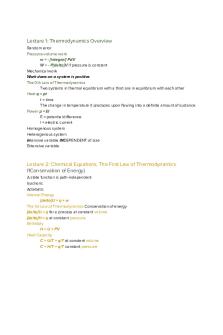
CHEM303 final exam review
- 4 Pages

Psychology Final Exam - Review
- 13 Pages
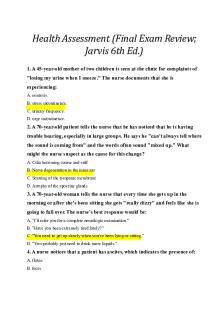
Jarvis Final Exam Review
- 12 Pages
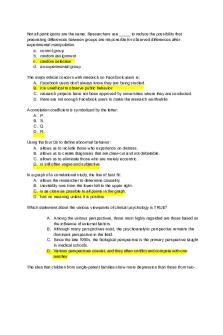
Final exam review
- 96 Pages
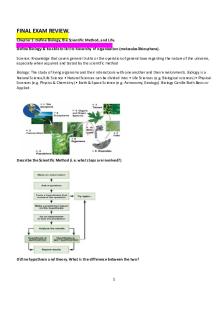
Final Exam Review
- 48 Pages
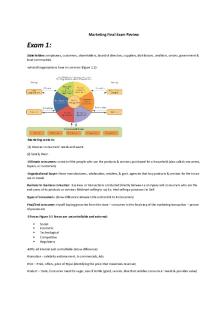
Marketing Final Exam Review
- 15 Pages
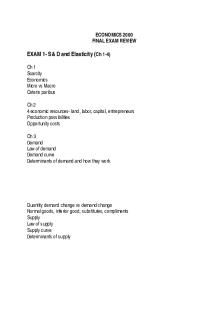
Final exam review
- 8 Pages
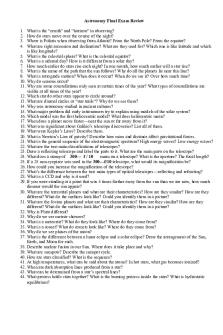
Astronomy Final Exam Review
- 2 Pages
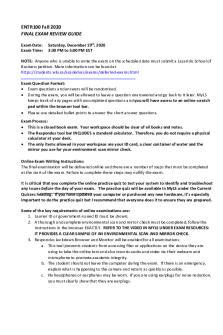
Final Exam Review Guide
- 4 Pages
Popular Institutions
- Tinajero National High School - Annex
- Politeknik Caltex Riau
- Yokohama City University
- SGT University
- University of Al-Qadisiyah
- Divine Word College of Vigan
- Techniek College Rotterdam
- Universidade de Santiago
- Universiti Teknologi MARA Cawangan Johor Kampus Pasir Gudang
- Poltekkes Kemenkes Yogyakarta
- Baguio City National High School
- Colegio san marcos
- preparatoria uno
- Centro de Bachillerato Tecnológico Industrial y de Servicios No. 107
- Dalian Maritime University
- Quang Trung Secondary School
- Colegio Tecnológico en Informática
- Corporación Regional de Educación Superior
- Grupo CEDVA
- Dar Al Uloom University
- Centro de Estudios Preuniversitarios de la Universidad Nacional de Ingeniería
- 上智大学
- Aakash International School, Nuna Majara
- San Felipe Neri Catholic School
- Kang Chiao International School - New Taipei City
- Misamis Occidental National High School
- Institución Educativa Escuela Normal Juan Ladrilleros
- Kolehiyo ng Pantukan
- Batanes State College
- Instituto Continental
- Sekolah Menengah Kejuruan Kesehatan Kaltara (Tarakan)
- Colegio de La Inmaculada Concepcion - Cebu